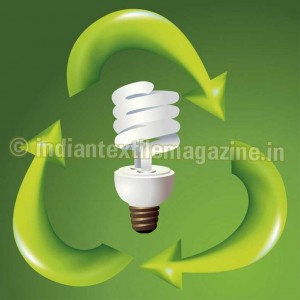 Global energy crisis along with the rising cost of fuel has made way for energy conservation in textile industries. Energy is also a significant factor in deciding the cost of a product. The conservation measures adopted by various textile units in order to reduce its operating costs are being discussed in The Textile Magazine from January 2014. This issue also continues to highlight the steps taken by a few manufacturers to optimize the energy cost and improve the operating and maintenance practices of the system.
Global energy crisis along with the rising cost of fuel has made way for energy conservation in textile industries. Energy is also a significant factor in deciding the cost of a product. The conservation measures adopted by various textile units in order to reduce its operating costs are being discussed in The Textile Magazine from January 2014. This issue also continues to highlight the steps taken by a few manufacturers to optimize the energy cost and improve the operating and maintenance practices of the system.
Indo Rama, India’s largest dedicated polyester manufacturer, has an integrated manufacturing complex at Butibori, near Nagpur in Maharashtra. The company has an annual capacity of 6,10,050 tonnes. Its product portfolio comprises of polyester stable fibre (PSF), polyester filament yarn (PFY), draw texturized yarn (DTY), fully drawn yarn and textile grade chips.
Energy saving, in order to achieve cost efficiency, has been practised through various measures by Indo Rama. By switching off the electrostatic precipitators’ (ESP) hopper heaters at the CF-HTM plant, the company was able to save considerably and also in the condensate extraction pump (CEP) in the captive power plant (CPP).
Indo Rama has installed a 75 kw spare variable frequency drive (VFD) pump for CEP in CPP unit-3 for energy saving. In the Barmag DTY machines, the company converted the old DC motors and analog drives with high efficient AC motors and drives and IM jets with air efficient jets (P-244) for 150/48 HIM and (P-247) for 300/96 products. Retrofitting of Centac air compressor 6-8 bar and stoppage of reciprocating air compressors done to save energy.
The cooler water was diverted from CP2 to CP1 for air compressors, which resulted in less operation of CW pumps. Indo Rama has installed energy efficient boiler feed pumps in fluidized bed combustion (FBC) boilers in the place of low efficiency pumps. The company converted its 4.5 bar Centac air compressor into two stages from three stages in order to reduce the power consumption. It was in a position to save power by supplying IM air in POY 2/3 and POY 5 through 3.0 bar system. The polyester manufacturer retrofitted 27 utility cooling and chilled water pumps.
In order to maintain the required temperature and pressure, Indo Rama installed De-superheater in the PSF-4 HP steam line. It saved power by reducing the use of AHU for CP-4 draw line oil room area and installing a desert cooler. The company was able to save 22 units/hr by reducing the inverter frequency from 30 hz to 25 hz of comfort air in PSF draw line and by reducing Quench return fan unit’s frequency from 50 Hz to 35 Hz.
Indo Rama reduced the refrigeration load in the DRR (Disc Ring Reactor) immersion vessel (CP5). It saved considerable energy by stopping one FO circulation pump in OF-HTM and by installing heat of compression type air dryer unit in instrument air circuit to reduce the pressure drop on higher flow. It also installed two vapour compressor chillers (VCC) in the place of old de-rated vapour absorption (VAM) chillers.
Banswara Syntex’ energy saving drive
 Banswara Syntex Ltd., a vertically integrated textile mill, manufactures man-made synthetic blended yarn, wool and wool mixed yarn, all types of fabrics, jacquard furnishing fabrics, besides production of readymade garments and made-up’s and technical fabrics.
Banswara Syntex Ltd., a vertically integrated textile mill, manufactures man-made synthetic blended yarn, wool and wool mixed yarn, all types of fabrics, jacquard furnishing fabrics, besides production of readymade garments and made-up’s and technical fabrics.
The company has been regularly taking effective steps to conserve energy where ever possible. During 2012-13, two additional 415 and 380 volt step down transformers were fixed in lighting to increase the life of fluorescent tubes and over 1000 louvers fixed to increase the light on the machines. The company monitored the leakage of compressed air in its Banswara Syntex Ltd. (BSL) and Banswara Fabric Ltd. (BFL) units which resulted in a saving of around Rs. 3 lakh per month.
By continuous condition monitoring of electric motors in all departments in BSL and BFL units, the company was able to reduce 18 per cent of motors from burning. It has also replaced old motors with energy efficient motors which has reduced break downs resulting in a saving of Rs. 1.50 lakh per annum. Inverters were fixed by the company during the winter on fans and pumps of H & V plants of BSL and BFL units, worsted spinning and thermal power plants resulting in a saving of electrical energy of around Rs. 20 lakhs.
Steam energy saving machines
A heat recovery plant was installed in the company’s thermal power plant costing Rs. 20 lakhs to recover the heat of blow down of boilers in the thermal plant, resulting in saving of around Rs. 3 lakh per month. The condensate of fibre dye house machine was collected in an underground tank, which helped save 2.5 lakh litres of water and raise the temperature of the feed water by eight degrees. Recycling of water from Mazera and jet dying machines in Banswara Textile Mills (BTM) unit resulted in a saving of 5 lakh litre of water a day.
In order to save the steam energy in its BTM unit and dye house, installations of heat recovery units are proposed to be acquired from Forbes Marshal P. Ltd., Pune, which will result in saving steam of around Rs. 100 lakhs per annum with a project cost of over Rs. 150 lakhs.